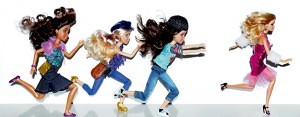A story in the April Fast Company has me thinking three ways:
When Mattel’s Barbie celebrated her 40th birthday, and my colleague and I represented the American College of Foot & Ankle Surgeons as its public relations firm for three years, the opportunity was too good to pass up.
My idea was to issue a press release on PR Newswire blasting Barbie for still wearing high heels every day through her fourth decade. The podiatric surgeons were none too pleased the media preferred to invite comments about Barbie’s footgear over their technologically advanced titanium implants.
Because my daughter was an early adopter of all things Bratz (those too sexy dolls that rivaled Barbie), and I followed progress of the legal battle between the two companies for intellectual property rights (Mattel won), I was eager to learn more about the new Liv dolls by Spin Master Toys.
I tore the Fast Company story for future reference. Upon a second glance at the headline, I was struck — “Watch Your Back, Barbie!!! How Spin Master Toys created the hit Liv dolls, a thoroughly modern marriage of tech, storytelling and 21st-century marketing that has industry giant Mattel looking over its shoulder.” (And, that’s just the headline.)
Storytelling! Forget about Barbie’s high heels and Bratz. Storytelling!
Spin Master Toys offers a perfect example of the role storytelling plays in brand development prior to product launch.
The new team hired by Spin Master developed a narrative for the four dolls in the collection BEFORE the dolls had a name. The team created an imaginary high school, and characteristics for each girl doll were inspired from teen behavior observed at surf shops, malls and frozen yogurt stands. Diversity was added to the story (rather than just in the skin tone and facial features of the dolls themselves) which directly aligned with toy industry trends about how little girls play. The back story for each Liv doll was a critical component of the go-to-market strategy.
Enter media relations.
With storytelling on the marketing and brand side of things aimed at the end user, public relations can pick up and add that rich flavor to content we develop to tell a story to a middle gatekeeper of news (in essence, we’re selling the story with a pitch).
Seeing this reference to storytelling prominently in the headline of a major business publication is a thoughtful exercise in looking at products differently. While public relations may not engage in consumer storytelling when pitching the media, you can bet we will engage in consumer storytelling within the realm of social media.
What examples might you have about how storytelling impacted a product launch, media relations situation, or social media opportunity? While you’re thinking, I’m going to take another look at Liv dolls at Target today.







Hi Jayme,
May I offer that EVERY “product launch, media relations situation, or social media opportunity” is an example of how storytelling impacted the result ~ isn’t storytelling narratives all there is ? Both positive and negative in terms of results.
Too often, it seems, people opt to skip the simple, yet effective, drill-down into the concerns of their desired audience to create a compelling story that the audience can easily connect with.
Thanks for reminding of the importance of storytelling in business, and more importantly the value that can be derived from taking the time to invent a comprehensive and robust narrative that drives transaction.
Sincerely with the best regards,
David Bookout
Now that I’m “turned on” or “tuned in” to storytelling, it is everywhere! Hadn’t really known about that side of marketing and its importance before meeting a Twitter pal.
Thanks for your valuable comments, David!
Fancy that, just three clicks away I found this thought percolating “story” on Barbie’s next career and had to come back to share it with ya’ll => ( https://bit.ly/cXViz3 ) !!…
Cheers,
David Bookout
Now that is funny — computer engineer Barbie! I like the girls/end users selected anchor woman. Now that’s a stereotype, eh? Thanks, David!